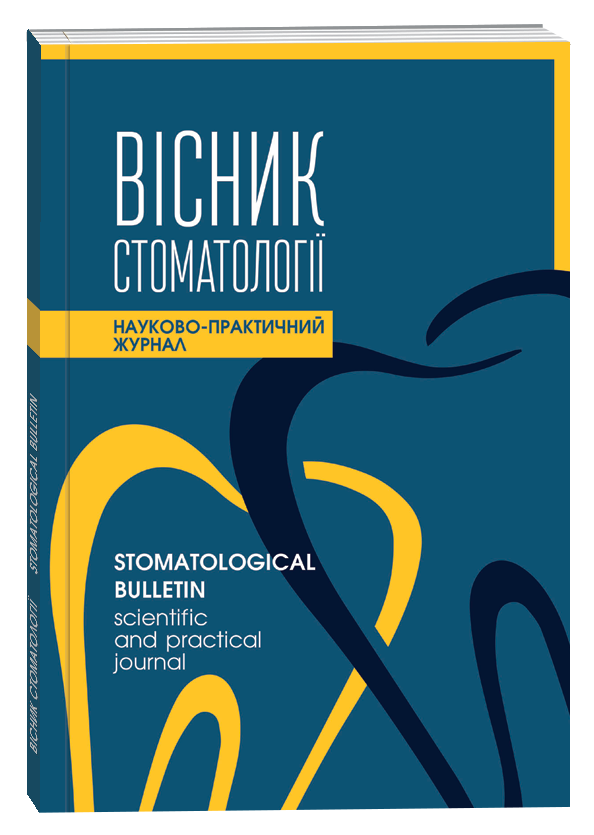COMPARATIVE ANALYSIS OF THE PREVALENCE OF GINGIVAL RECESSION IN PATIENTS WITH GENERALIZED PERIODONTITIS DEPENDING ON GENDER
DOI:
https://doi.org/10.35220/2078-8916-2020-36-2-33-38Keywords:
periodontitis, gingival recession, prevalence, maxilla, mandibleAbstract
Introduction. Gingival recession is a clinical condition that is common in the dental practice of dentists.
Aim. To determine the prevalence of gingival recessions in patients with generalized periodontitis depending on gender.
Materials and methods. The study involved 133 patients with generalized periodontitis aged 29 to 59 years, who underwent a comprehensive periodontal examination us-ing the Florida Probe system. Patients were divided into two groups depending on gender.
Results of the study showed that the prevalence of gingi-val recessions in patients with generalized periodontitis among females was 78.57 (50.00-91.36) % and it was significantly higher (p = 0.047) compared to males in which the prevalence of gingival recession was 69.23 (39.28- 82.14) %. A comparative analysis of the preva-lence of gingival recessions in the mandible between the two groups showed that the prevalence of gingival reces-sions in females was statistically higher than in males (p = 0.035). The maxillary right canine and mandibular left first incisor were the teeth most frequently and most seri-ously associated with a gingival recession in males, while in females it was the maxillary first right incisor and mandibular first left incisor. According to the severity, in females, the gingival recession with vertical width 1-2 mm was observed in 46.0 (41.6-50.5) % of cases, in males – in 41.7 (37.1-46.4) %. The gingival recession with vertical width 3-4 mm in females was observed in 19.8 (15.3-24.5) %, while in males this indicator was 14.6 (10.6-18.7) %. Gingival recession with vertical width of 5 mm or more occurred more often in males than in females: 4.8 (1.8-7.9) % and 4.0 (2.1-6) %, respectively.
Conclusions. In this study, the prevalence of the gingival recession was higher in females among the examined groups. Females are more prone to develop gingival re-cession on the mandible than males. Gingival recession with the vertical width of 1-2 mm and 3-4 mm is more common in women, while gingival recessions with a verti-cal width of 5 and more mm in men.
References
Baker P., Spedding C. The aetiology of gingival recession. Dent Update 2002;29:59–62.
Patel M., Nixon P.J., Chan M.F. Gingival recession: Part 1. Aetiology and non-surgical management. Br Dent J 2011;211:251−254.
Zweers J., Thomas R.Z., Slot D.E., Weisgold A.S., Van der Weijden G.A. Characteristics of periodontal biotype, its dimensions, associations and prevalence: a systematic re-view. J Clin Periodontol 2014;41(10):958-971.
Pradeep K., Rajababu P., Satyanarayana D., Sagar V. Gingival recession: review and strategies in treatment of re-cession. Case Rep Dent 2012;2012:1–6.
Nguyen-Hieu T., Ha-Thi B. Gingival recession associ-ated with predisposing factors in young vietnamese: a pilot study. Oral Health Dent Manag 2012;11:134–144.
Checchi L., Daprile G., Gatto MR.A., Pelliccioni A. Gingival recession and toothbrushing in an Italian School of Dentristy: a pilot study. J Clin Periodontol 1999;26:276–280.
Kozlowska M., Wawrzyn-Sobczak K., Karczewski J.K., Sokowska W. The Oral cavity hygiene as the basic ele-ment of the gingival recession prophylaxis. Rocz Akad Med Bialymst 2005;50:234–237.
Chrysanthakopoulos N. A. Gingival recession: preva-lence and risk indicators among young Greek adults. J Clin Exp Dent 2014;6:243–249.
Toker H., Ozdemir H. Gingival recession: epidemiolo-gy and risk indicators in a university dental hospital in Turkey. Intern J Dent Hyg. 2009;7:115-20.
Khocht A., Simon G., Person P., Denepitiya J.L. Gingival recession in relation to history of hard toothbrush use. J Periodontol 1993;64:900–905.
Danylevskyi N. F., Borysenko А. V. Zabolevania parodonta [Periodontal disease]. К.: Zdorovia; 2000:467.
Olsson M., Lindhe J. Periodontal characteristics in individuals with varying form of the upper central incisors. J Clin Periodontol 1991;18:7882.
Fu J.H., Yeh C.Y., Chan H.L., Tatarakis N., Leong DJ.M., Wang H.L. Tissue biotype and its relation to the under-lying bone morphology. J Periodontol 2010;80: 569–574.
Mazur I.P. Kliniko-patogenetychni osoblyvosti perebigu zahvorjuvan' parodonta pry porushenni systemnogo kistkovogo metabolizmu ta i'h korekcija [Clinical and pathogenetic features of the course of periodontal diseases in violation of systemic bone metabolism and their correction]. Dissertation of doctor of medi-cal sciences . Kyiv:NMAPO;2006. 322 p.
De Rouck T., Eghbali R., Collys K., De Bruyn H., Cosyn J. The gingival biotype revisited: transparency of the periodontal probe through the gingival margin as a method to discriminate thin from thick gingiva. J Clin Periodontol. 2009;36:428–433.
Muller H.P., Heinecke A., Schaller N., Eger T. Masticatory mucosa in subjects with different periodontal phenotypes. J Clin Periodontol 2000;27:621-626.
Aishwarya J., Dr. Radhika A. Assessment of gingival thickness with regard to age, gender and location in the dental arch – a clinical study. International Journal of Pharmaceutical and Clinical Research 2015; 7(6): 399-401.
Ochsenbein C., Ross S. A reevaluation of osseous surgery. Dent Clin North Am 1969;13:87-102.
Vandana K.L., Savitha B. Thickness of gingiva in as-sociation with age, gender and dental arch location. J Clin Periodontol 2005;32:828–30.
Cuny-Houchmand M., Renaudin S., Leroul M., Planche L., Guehennec L.L., Soueidan A. Gingival biotype assessement: visual inspection relevance and maxillary versus mandibular comparison. Open Dent J 2013;7:1–6.
Bowers G.M. A study of the width of attached gingi-va. J Periodontol 1963;34: 201–209.
De Rouck T., Eghbali R., Collys K., De Bruyn H., Cosyn J. The gingival biotype revisited: transparency of the periodontal probe through the gingival margin as a method to discriminate thin from thick gingiva. J Clin Periodontol. 2009;36(5):428–433.
Eger T., Muller H.P., Heinecke A. Ultrasonic deter-mination of gingival thickness. Subject variation and influence of tooth type and clinical features. J Clin Periodontol 1996;23:839-845.
Muller H.P., Schaller N., Eger T., Heinecke A. Thickness of masticatory mucosa. J Clin Periodontol 2000;27:431-436.









